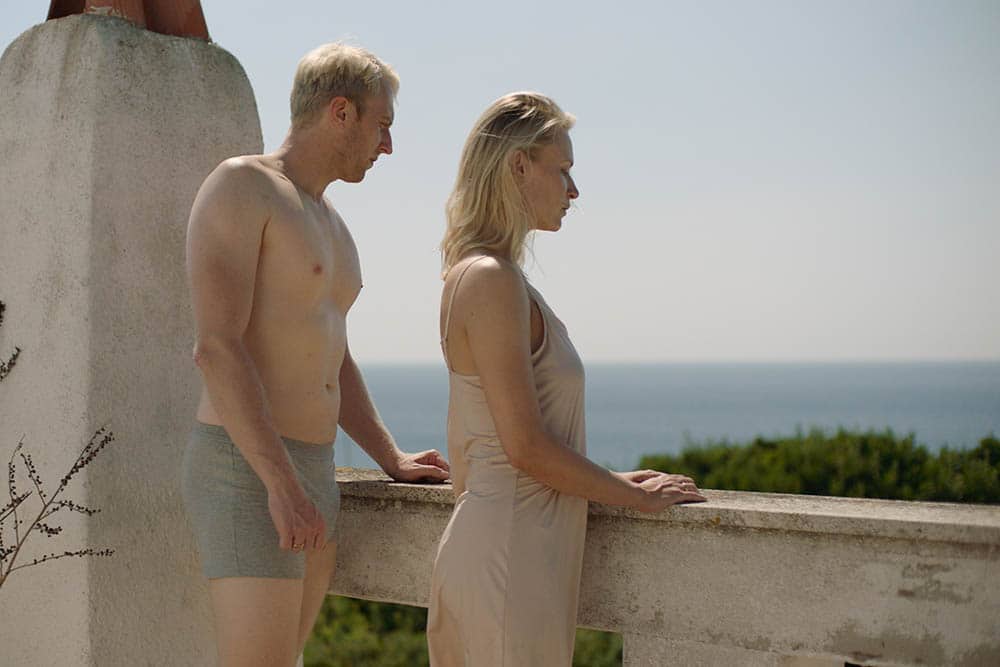
Silent Land (Cicha Ziemia, 2021), is a supremely confident work from first time feature director Aga Woszczyńska. It’s evident that she’s in command of her craft from the first to the last image. She navigates tonal and narrative shifts with ease, explores topical thematic issues, and ends the film with a subtle spark of brilliance.
Polish couple Anna (Agnieszka Zulewska) and Adam (Dobromir Dymecki) arrive at their Italian rental home to find the swimming pool is empty. The arrival of a migrant worker to fix the fault is a distraction to the start of their holiday. After a fatal accident poolside, the disruption continues as they are interrogated by the police. The closure of the investigation should allow them to enjoy their holiday, but the incident burrows at their conscience, stirring up animosity between the couple.
Silent Land opens with a soothing view of the sea, underscored by only the diegetic sounds of the Italian coast. Woszczyńska chooses to not use music, encouraging her audience to feel a sense of calm. This choice feeds the film’s aesthetic, whose camera lacks urgency.
Anna and Adam’s assertiveness with their host reveals an intensity, but it’s an energy that’s repressed. When they make love, Woszczyńska and her cinematographer Bartosz Swiniarski discreetly conceal the couple as semi-silhouettes, shooting the scene from a distance that positions their audience as peeping toms.
With shades of Michelangelo Antonioni’s observational approach, Silent Land creates a distance between the characters and the audience. Anna and Adam move in and out of the shot, or the camera is deliberately positioned so parts of the image are outside of the frame. There’s a contradiction to this approach because it distances the audience, yet requires them to enter the film to understand the characters.
At first, it seems that Woszczyńska and her co-writer Piotr Jaksa Litwin are not interested in explaining the point of the drama. That is until Silent Land undergoes a metamorphosis. A film of two halves, this cold and distanced aesthetic thaws, giving way to a traditional approach to cinematography.
This choice coincides with the narrative’s development and its engagement with themes and ideas, which will make it palatable to a broader audience. The fatal accident denies the couple the opportunity to isolate themselves in their villa and pool any longer, and the audience is no longer treated as an invasive presence. The attempts to sustain the calm of the opening image end.
Looking beyond the temptation to critique the bourgeoise, Silent Land is a response to the European immigration crisis. The military presence and the comments about welcome and unwelcome guests echo the xenophobia towards migrants and asylum seekers. Anna and Adam’s indifference and the prejudice of the investigators address the bias towards the value of human life. The transactional relationship between the couple as tourists and the town increases their value, unlike the unwelcome immigrant who has none.
Woszczyńska and Litwin present us with a moral story that deepens the contradictions between the two halves. Witnessing the lies and the prejudicial investigation provokes anger at the injustice perpetrated and motivates our emotional investment in the drama. The audience has no choice other than to judge Anna and Adam, but their familiarity with the couple lends a bias to their moral judgement.
Instead, the audience might place themselves in the couple’s position, challenging their moral instinct to condemn. In hindsight, Silent Land could leave its audience with a pang of guilt for doubting the need to admonish the couple. It reminds us that morality is not impervious to impulses that compromise our ethical integrity.
[Spoiler Alert] The aesthetic of the first half of the film underpins an idea expressed towards its end when Adam comes across a wounded dog. If he were not shouldering the guilt for his role in the migrant worker’s death, would he stop to attend to the dog?
In everyday life, such moments are not presented to us. These are the consequences of the author’s control of the story and their desire to create layers of meaning in their characters’ lives. It’s unlikely Adam would have the opportunity at redemption he has in Silent Land if this were real life. Instead, he’d have to learn to live with the guilt and the shame.
If cinema could learn to explore this flexibility of changing aesthetic and narrative tones, it could open up the possibility to evolve in a new direction. It would liberate film from the inflexibility aesthetic and narrative choices, and challenge its audience in new ways. Strangely, recalling James Wan’s Insidious (2010), Woszczyńska is not alone in her endeavour to ask why cinema must conform to rigid practices. But their voices are whispers that fall on deaf ears.

